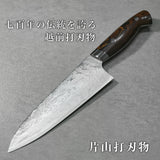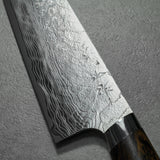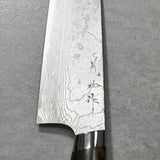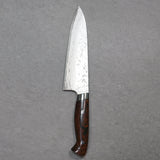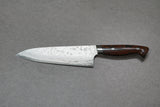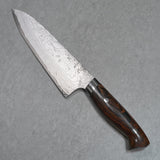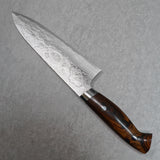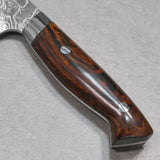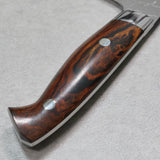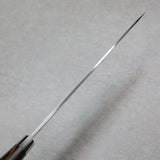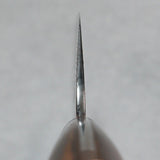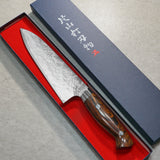Yuta Katayama Super Gold 2 Damascus Gyuto Chef Knife 180mm Ironwood Reimei

Blacksmith: Yuta Katayama
Type: Gyuto / Chef's Knife (Double bevel edged)
Blade Material: Super Gold 2 SUMINAGASHI(Damascus) Clad Stainless Steel
Core: Super Gold 2 (Powder Stainless High Speed Steel)
Blade Length: approx 180mm (7")
Blade Width: approx 50mm
Thickness of Spine: approx max 2.8mm
Overall Length: approx 300mm
Weight: approx 193g (6.8oz)
HRC: 62-63
Handle: Ironwood
Echizen Uchi Hamono, renowned as 'Traditional Crafts' by the Minister for Economy, Trade and Industry, are forged in Echizen City, boasting a 700-year-old tradition of Japanese knife-making. These meticulously forged knives exhibit exceptional chip resistance and exceptional edge retention. Microscopic examination reveals a remarkably homogeneous material structure.
Mr. Katayama, a master craftsman based in Echizen City, creates exquisite custom field and kitchen knives. His designs are renowned for their ergonomic grip, striking aesthetics, and unparalleled originality. Indeed, many Japanese have never encountered such remarkable features as his acid-etched Damascus blades and knives with elegant ironwood handles.
The elegant "Sumi Nagashi" wave pattern, a hallmark of Japanese cutlery culture, is a testament to the artistry of Echizen Uchi Hamono. Similar to a Katana, the blade is meticulously crafted by layering softer and harder steels, resulting in a unique and mesmerizing pattern. The acid-etched surface, with its uneven texture, not only enhances the blade's aesthetic appeal but also contributes to a luxurious feel and facilitates effortless release of ingredients.
NIMAI-HIROGE(Spreading Two Sheets)
NIMAI-HIROGE, a unique forging technique exclusive to Echizen City, exemplifies exceptional craftsmanship. This method involves simultaneously forging two blades together, maintaining a consistent high temperature. By preventing rapid cooling, blacksmiths can strike the blades repeatedly, ensuring optimal heat distribution and minimizing carbon loss. This technique, while seemingly simple, demands years of dedicated practice. Even skilled blacksmiths may require five years to master this intricate art.
About "Super Gold 2"
Super Gold 2 is a registered trademark of Takefu Special Steel Co., Ltd., produced through powder metallurgy, resulting in a high concentration of alloying elements. This exceptional steel boasts superior corrosion resistance, exceptional hardness, exceptional toughness, and exceptional wear resistance. Despite its high Rockwell Hardness (HRC), it remains relatively easy to resharpen, while exhibiting outstanding edge retention. These remarkable qualities have earned Super Gold 2 the preference of many renowned Japanese chefs.
NOTE:
Thoroughly wash, dry, and wipe the knife after each use to prevent rust. If rust appears on the blade's edge, remove it with a sharpening stone. For rust on the blade itself, use a mild cleanser (for stainless steel) or a fine-grit scourer (for iron steel), being mindful of potential scratches.
To prevent damage, avoid twisting the blade or striking it against hard surfaces. Cutting frozen foods or bones can chip or break the thin, sharp edge of Japanese knives. As these knives are meticulously handcrafted, slight variations and minor scratches may naturally occur.













